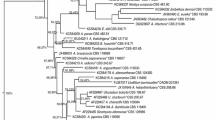Abstract
We report the in vitro phytopathogen suppression activity of siderophoregenic preparations of Alcaligenes feacalis vis-à-vis the oraganochlorine fungicide, bavistin. Siderophore-rich culture broth, siderophore-rich supernatant, and purified siderophore preparation exerted antifungal activity against Aspergillus niger NCIM 1025, A. flavus NCIM 650, Fusarium oxysporum NCIM 1008, and Alternaria alternata IARI 715. Among all the preparations, siderophore-rich broth exhibited potent antifungal activity. The minimum fungicidal concentration required was 75 μl for A. niger and F. oxysporum and 50 μl for A. flavus and A. alternata.

Similar content being viewed by others
References
Bloemberg GV, Lugtenberg BJJ (2001) Molecular basis of plant growth promotion and biocontrol by rhizobacteria. Curr Opin Plant Biol 4:343–350
Budzikiewicz W (1993) Secondary metabolites from fluorescent pseudomonads. FEMS Microbiol Rev 204:209–228
Chincholkar SB, Chaudhari BL, Talegaonkar SK, Kothari RM (2000) Microbial iron chelators: a tool for sustainable agriculture. In: Upadhayay RK, Mukherji KG, Chamola BP (eds) Biocontrol potential and their exploration in crop disease management, vol I. Kluwer Academic, New York, pp 49–70
Estrella AF, Chet I (1998) Biocontrol of bacteria and phytopathogenic fungi. In: Altman A (ed) Agriculture biotechnology. Marcel Deckker, New York, pp 263–282
Johri BN, Sharma A, Virdi JS (2003) Rhizobacterial diversity in India and its influence on plant health. In: Ghose TK, Ghosh P (eds) Advances in biochemical engineering biotechnology, vol 84. Springer Verlag, Berlin, pp 49–89
Lemanceau P, Albouvette A (1993) Suppression of Fusarium wilts by fluorescent pseudomondas: mechanism and applications. Biocon Sci Technol 3:219–234
Lugtenberg BJJ, Thomas FC, Woeng AC, Blomberg GV (2002) Microbe–plant interactions: principles and mechanisms. Antonie van Leeuwenhock 81:373–383
Manwar AV, Vaigankar PD, Bhonge LS, Chincholkar SB (2000) In vitro suppression of plant pathogens by siderophores of fluorescent pseudomonads. Ind J Microbiol 40:109–112
Mazzola M (2002) Mechanism of natural soil suppressiveness to soil borne diseases. Antonie van Leeuwenhock 81:557–564
Meyer JM, Abdallah MA (1978) The fluorescent pigments of Fluorescent pseudomonas: biosynthesis, purification and physicochemical properties. J Gen Microbiol 107:319–328
Milagres AMF, Machuca A, Napoleao D (1999) Detection of siderophore production from several fungi and bacteria by a modification of chrome Azurol S (CAS) agar plate assay. J Microbiol Methods 37:1–6
Nehl DB, Allen SJ, Brown JF (1996) Deleterious rhizosphere bacteria: an integrating prospective. Appl Soil Ecol 5:1–20
Pieterse CMJ, van Pelt JA, van Wees SCM, Ton J, Leon-Kloosterziel KM, Keurentjes JJB, Verhagen BMW (2001) Rhizobacteria mediated induced systemic resistance: triggering, signaling and expression. Eur J Plant Pathol 107:51–61
Plessner O, Klapatch T, Guerinot ML (1995) Siderophore utilization by Bradyrhizobium japonicum. Appl Env Microbiol 59:1688–1690
Saikia N, Bezbruah B (1995) Iron dependent plant pathogen inhibition through Azotobacter RRL J203 isolated from iron rich acid soil. Ind J Exp Biol 35:571–575
Sayyed RZ, Chincholkar SB (2006) Purification of siderophores of Alcaligenes feacalis on Amberlite XAD. Biores Technol 97(8):1026–1029
Sayyed RZ, Naphade BS, Chincholkar SB (2005) Ecologically competent rhizobacteria for plant growth promotion and disease management. In: Rai MK, Chikhale NJ, Thakare PV, Wadegaonkar PA, Ramteke AP (eds) Recent trends in biotechnology. Scientific, Jodhpur, India, pp 1–16
Sayyed RZ, Naphade BS, Chincholklar SB (2007) Siderophore producing A. feacalis promoted the growth of Safed musali and Ashwagandha. J Med Aromat Plants 29:1–5
Sayyed RZ, Patel DC, Patel PR (2007) Plant growth promoting potential of P solubilizing Pseudomonas sp. occuring in acidic soil of Jalgaon. Asian J Microbiol Biotechnol Environ Sci 4:925–928
Schwyn R, Neilands JB (1987) Universal chemical assay for detection and determination of siderophores. Anal Biochem 160:47–56
Sindhu SS, Suneja S, Dadarwal KR (1997) Plant growth promoting rhizobacteria and their role in crop productivity. In: Dadarwal KR (ed) Biotechnological approaches in soil microorganisms for sustainable crop production. Scientific, Jodhpur, India, pp 149–193
Thrane C, Harder NI, Neiendam NM, Sorensen J, Olson S (2000) Visconiamide producing Pseudomonas fluorescence DR 54 exerts a biocontrol effect on Pythium ultimum in sugar beet. FEMS Microbiol Ecol 33:39–46
van Wees SCM, de Swart EAM, van Pelt JA, van Loon LC, Pieterse CMJ (2000) Enhancement of induced disease resistance by simultaneous activation of salyclate and jasmonate dependent defense pathway in Arabdopsis thaliana. Proc Natl Acad Sci USA 97:8711–8716
Acknowledgment
Financial assistance to the corresponding author from the Board of Research in Nuclear Science (BRNS), Department of Atomic Energy (DAE), Government of India, under the scheme of research award for young scientist is greatly acknowledged.
Author information
Authors and Affiliations
Corresponding author
Rights and permissions
About this article
Cite this article
Sayyed, R.Z., Chincholkar, S.B. Siderophore-Producing Alcaligenes feacalis Exhibited More Biocontrol Potential Vis-à-Vis Chemical Fungicide. Curr Microbiol 58, 47–51 (2009). https://doi.org/10.1007/s00284-008-9264-z
Received:
Revised:
Accepted:
Published:
Issue Date:
DOI: https://doi.org/10.1007/s00284-008-9264-z




